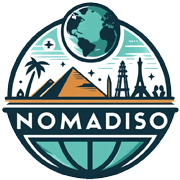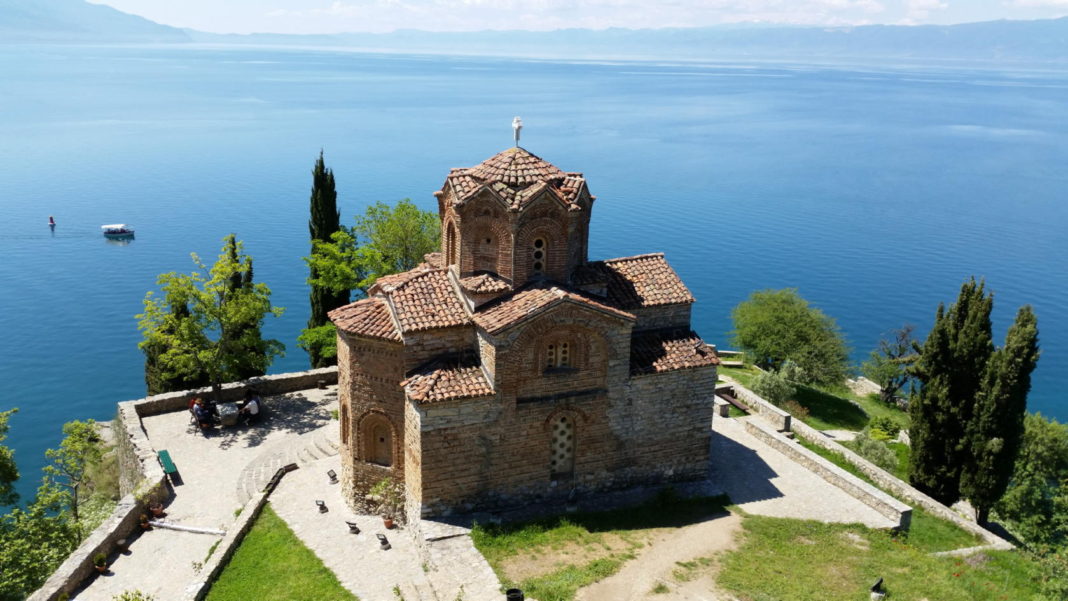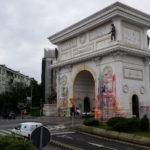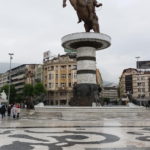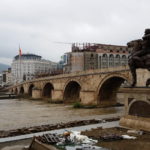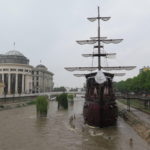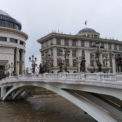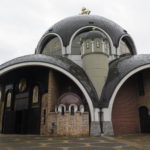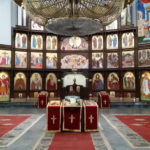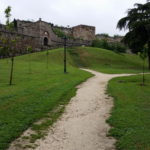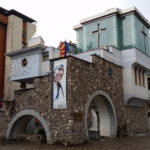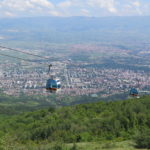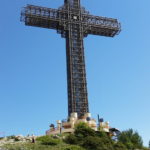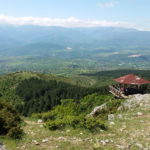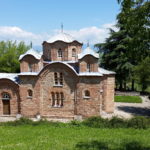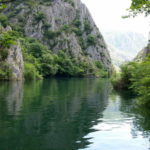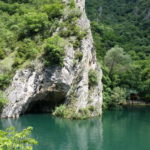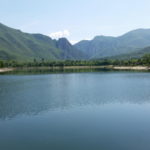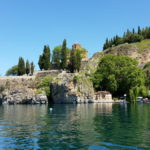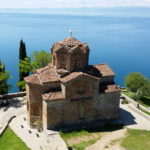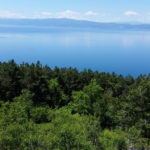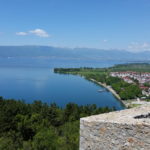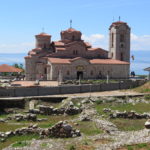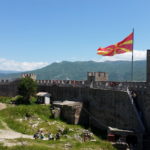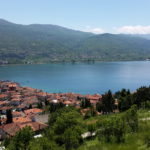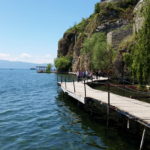Thanks to Wizz Air, in March 2016, new horizons opened up to the heart of the Balkan Peninsula – Macedonia. Roundtrip flights Bratislava – Skopje starting at €20 cannot leave any globetrotter indifferent. Despite the devastation caused by a huge earthquake in 1963, the capital city Skopje continues with its megalomaniacal plans.
Imagine dozens of statues and fountains in the squares and along the river, with music from the local radio. The city is dominated by a 66-meter-high cross, which puts on its light show every evening. Beyond the city borders, the breathtaking Matka Canyon, Lake Ohrid, and a perfect extended weekend are waiting to be explored.
Detailed Google map with attractions
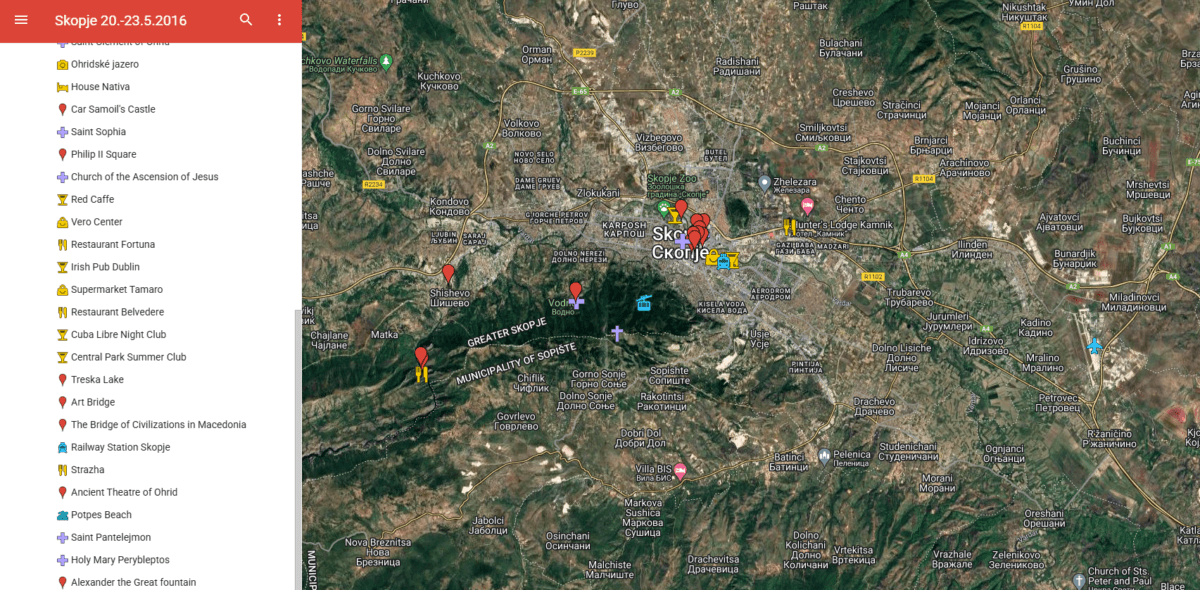
Contents
Day 1 – Night arrival
Day 2 – Downtown Skopje
Day 3 – Millennium Cross and Matka Canyon
Day 4 – Enchanting Ohrid
Day 1 – Late Night Arrival
We have a flight from Bratislava on Friday at 21:10. With a slight delay, we will land in Skopje sometime after 23:00. At this time, it’s problematic to find buses, so we arranged a taxi service in advance via email. The price from the airport seems set at 20€, but we have a tip on how to save.
Through the company Bel Skopje Taxi, you can pre-arrange a price of 15€. They prefer communication via WhatsApp at +389 71 755 252, where they reply within 24 hours.
In the arrival hall, our taxi driver is waiting with a sign. We withdraw Macedonian denars from an ATM to have some cash, although paying with euros or card was also not a problem. During our visit, the exchange rate was 1 EUR = 61.47 MKD. Outside, a Mercedes E-Class with the driver awaits us, and we end up having more conversation in Slovak than in English. Little do we know what experiences await us with this car, but more on that later. It’s about a 20-minute drive from the airport to the main train station, where we will be staying. We chose accommodation at blueWave.place as usual through Booking and it turned out to be a great choice. The apartment with three bedrooms, a dining room, living room, and balcony is located in a high-rise building at the very top overlooking the cross above Skopje. To enter the building, you use a PIN, and the keys drop out after solving the coded box in front of the door, so we didn’t even see the owner. It’s around midnight, and next to us is the Red Caffe still open.
The first challenge is that everything is in Cyrillic, so we prefer to ask in English for a “local draft beer.” A domestic beer for welcome is just what we need, and we pay 80 MKD for a bottled third of Skopsko. The café is open only until one o’clock, so we contemplate what to do with the early night. We ask them to call a taxi for us and let ourselves be driven to a lively spot. To our surprise, we only paid 150 MKD, which is about 2.50€. We find ourselves in front of Central Park Summer Club, and the entrance fee is 220 MKD. The venue operates as an open-air disco with a live band, and despite the weather, it was full. In terms of prices, it’s comparable to ours; a vodka with juice costs 200 MKD. We have drinks, dance, and around 3 a.m., we head home. Since it’s pouring rain, we take the first taxi that comes our way. This time, the same route cost us 10€, so it’s better to call a taxi via WhatsApp or negotiate the price in advance.
Day 2 – Skopje City Center
The weather today won’t be a great motivator; it’s overcast, and it looks like it will rain all day according to the forecast. Nevertheless, we continue with our plan to explore the corners of the city center.
A guided city tour starts at 10:00 by the statue of Alexander the Great.
As a first stop, we arrive at the Triumphal Arch Porta Macedonia. Something doesn’t seem right here because the arch strikingly resembles the one in Paris and is completely covered in paint. From the taxi driver, we learn that there are protests happening these days against the construction of monuments. The locals do not identify with the culture being built in the city and see it as a big farce. The government has wrapped the construction of the city’s kitsch under the strategic project Skopje 2014. And when we find out that the average salary is €200 net and prices are like ours, there is really something to protest against. We walk through Macedonia Square, the pride of which is the majestic statue of Alexander the Great with a fountain. It is followed by a trio of bridges over the Vardar River – Stone Bridge, Bridge of Civilizations, Art Bridge.
And here begins the impression of mixed apples and pears. The Stone Bridge dates back to the 15th century, the Bridge of Civilizations strikingly resembles the Charles Bridge in Prague, and the Bridge of Art is full of sculptures of artists and musicians. Between the bridges, there is a ship built in an ancient style, sitting on a static pedestal. In the middle of the river, there are three large Babylon willow trees from New Zealand, each of them reportedly costing 250,000 USD. The numerous restaurants along the promenade and the constant rain convinced us that it was time for lunch. We had kebabs, hamburgers, the local specialty of Vardar, and beer. When things calm down a bit, we return on the other side of the bank towards the stone bridge. Ancient music starts playing on the radio, creating a cozy atmosphere. If we were to speak for our group, half of the crew liked the city’s style, while the other half found it pure kitsch.
The price of a magnet is a fixed 60MKD, bargaining won’t work here.
We arrive at Philip II Square with a fountain. Crossing the bridge, the old trading quarter Old Bazaar begins. Stone alleys are lined with clothing and souvenir shops. Our route leads past the Orthodox Church of the Ascension of Jesus. In terms of religion, it’s 70% Orthodox and 30% Muslims, so in every city you can see at least 1-2 mosques. We climb up to the fortress Kale Fortress, built in the 6th century. The walls rise above the Vardar River, offering a view of the entire metropolis and Mount Vodno. Compared to the fortress in Ohrid, it is about two grades weaker.
On the way back, we stop at Mustafa Pasha’s Mosque. We need to take off our shoes and can also visit the interior. We let our feet rest with another beer and a Balkan burek. If you haven’t tried this specialty yet, it’s pastry filled with meat for just a few denars. As we sit, a little girl approaches us with a box of wet wipes and writes something on the table with white chalk. “Atiga, I’m Atiga,” she introduces herself and asks for a contribution. In the end, she and her friend chatted very well in Slovak-Macedonian and she left with a quite good reward. The waiters know these children, and apparently, they live in harmony here. We wait for the rain to stop so we can move on. We head to the main and largest Orthodox church, the Church of St. Clement of Ohrid. Clement of Ohrid was a disciple of Saints Cyril and Methodius and after being expelled from Great Moravia, he brought the modified Glagolitic script, now Cyrillic, and the Christian faith here.
We continue along Boulevard Macedonia and turn left to reach the Memorial House of Mother Teresa, her birthplace. Although it no longer exists today, you can see a model of it and items from Mother Teresa’s life in the museum. On the way back home, we stop at the Vero shopping center. A quick check of clothing prices at New Yorker and Intersport shows they are comparable to ours. We buy some groceries at a supermarket and a few cans for the evening. From our accommodation, we have a prime view of the Millennium Cross, which is on our agenda for tomorrow. Since we will need several transfers tomorrow, we thought about arranging a taxi via WhatsApp. Bel Skopje Taxi offered us the best driver who will be with us all day for €20. Not bad 🙂
Day 3 – Millenium Cross and Matka Canyon
We wake up to a beautiful sunny morning. Before leaving, we need to pack our things because we will be staying in Ohrid tonight. We agreed on a later check-out time, so we just make a quick stop to pick up our stuff. Waiting for us in front of our apartment is a Mercedes C-Class with the taxi driver Goran. Besides speaking perfect English, he is an incredible guide, so we instantly like him. Our first point of interest is the Millenium Cross on the top of Vodno mountain, where we plan to take a cable car ride. The road winds up the mountain with Goran providing us with explanations at the first viewpoint. He mentions that the landscape has changed over the years, a select few in the government are doing well, while the rest of the people struggle with an average salary of €200 net. He tells us about protests against city development and shares some personal stories, like living in Chicago.
Interestingly, at the northern end of the city, there is the largest Roma settlement in Europe called Šuto Orizari, known as Šutka colloquially. Upon arrival at the parking lot, we find out that the cable car only starts running at 10:00. So, we decide to take a short walk around the area. Today, there are trail running and cycling races up Vodno mountain, adding to the lively atmosphere. The cable car starts exactly at ten. The round trip ticket turns out to be surprisingly cheap, only 100MKD. The 8-person gondola takes you up in less than 8 minutes. Its modernity is evident from the external bike rack. From the top, there is a beautiful view in all directions.
If you have enough time, Vodno Peak is the perfect spot for a picnic.
We’ll take panoramic photos and explore the souvenir stands, as today it’s bustling with athletes. I almost regretted not going for a run. After taking our final selfie with the cross, we can hop on the cable car. Goran is already waiting for us in the parking lot. Our next stop is the Church of Saint Panteleimon from the 12th century in the village of Gorno Nerezi. There was an entrance fee, so we only admired it from the outside. Across from the church is the Macedonian Village complex, showcasing typical Macedonian houses.
From the mountainous terrain, we head back to the city and take the main road towards the #1 attraction according to TripAdvisor, the Matka Canyon. There’s only one road leading to the valley, so come early to find parking. We have it easy as Goran takes care of everything and parks in a taxi spot. Initially resembling wild waters in Čuňovo, it gradually reveals a stunning canyon with a river. It’s just a few minutes until you’re greeted by a sign for Canyon Matka and a huge dam used for generating electricity and irrigation.
Lake Matka is the oldest artificial lake in Macedonia, named after the Virgin Mary. You have two options: pay for a boat trip to the cave for 400MKD or enjoy a leisurely stroll – we opt for the latter due to long boat queues. After passing a restaurant, a gentle hike on a stone path begins. We walked about 2km until the water reached our knees. In total, we covered around 5km in a loop. The way back was completely blocked with cars parked on both sides, making it a slow walk. None of us would want to be a bus driver in that moment. On our way home, Goran stops at Lake Treska and shares stories from his youth. Nowadays, swimming is not advisable due to pollution, but it used to be a great spot.
Upon arrival in Skopje, we head straight to the main station to find transportation to Ohrid, either by a combination of train and bus. For the four of us, the round trip costs around €50, plus we need to consider a taxi ride to the airport for €15. On top of that, there is Goran’s offer of a taxi for €100, which is too good to refuse. We quickly grab our things, leave the keys in the safe box, and hop into the taxi.
We will go to Ohrid with the first taxi driver who drove us from the airport. The driver, Macka, is more of a serious type, so we accept that there won’t be much joking around. We switch vehicles at a gas station where Goran recommended a truly excellent pizza. Before the long journey, we buy some water and we are ready to go. The distance from Skopje to Ohrid is 170km, which according to Google Maps should take us 2.5 hours. The road leads through highway sections where tolls are collected. Noteworthy is the nearly 20km “need for speed” section after the town of Tetovo, which is a straight line on the map. One must be careful as you will encounter speedsters and road pirates here. After the intersection towards [jazero Mavrovo](https://en.wikipedia.org/wiki/Mavrovo_Lake), the road goes into the hills with the first switchbacks. And it’s here where the first problems with the taxi start, in the form of overheating from the radiator.
We park on the side and Macka desperately pours all the water we bought. Our only luck. With these supplies, we reach the top of the mountain pass Strazha at an altitude of 1250m, where Macka again refills the water and replenishes the water bottles at a restaurant. We’re about halfway, so we decide to have a small snack. On the way down the hill, we see a burnt bus, only the skeleton remains. With a few more replenishment stops and a two-hour extension to the journey, we finally arrive in [Ohrid](https://en.wikipedia.org/wiki/Ohrid). Although we sent a text message about our delay to the accommodation, they only operate on WhatsApp, so they didn’t receive it. We toast to the challenging journey at the Fortuna restaurant and the Irish Pub. And since this is our first and last evening here, we also peek into the Cuba Libre Night Club.
Day 4 – Enchanting Ohrid
As it has become a good tradition, at least once during a trip, I must go for a morning run or bike ride. So in the morning, I managed to do a [3km run](https://www.strava.com/activities/585141007) along the lake. We solved breakfast with a purchase from the supermarket across the street, and we can start exploring the city. There is a legend about medieval Ohrid that at one point the city had 365 chapels – one for each day. That’s why Ohrid was also called the Slavic Jerusalem. The biggest attraction and landmark of the whole city is the large freshwaterLake Ohrid, which forms the border between Albania and North Macedonia. In May, with a water temperature of 13°C, it’s only for the brave, but in summer, it can be great. The water in the lake is crystal clear, with ladders at entry points leading to a pebbly bottom. Locals refer to Lake Ohrid and Lake Prespa, situated at the crossroads of Greece, Albania, and North Macedonia, as the “Macedonian Eyes” due to their locations. As we stroll along the shore, a boatman approaches us.
Negotiate the boat ride fare and ask to be dropped off at the Church of St. John.
Without hesitation, we embark on a circular boat tour along beaches and rocky cliffs. In the distance, snow can be seen capping the hilltops. After about a 20-minute cruise, we disembark at Kaneo Beach near the small church of the Nativity of the Virgin Mary. Descending the stairs, we arrive at the most picturesque spot – St. John at Kaneo Church. Once again, entrance is requested, which we decline, opting instead to admire the views of the vast sea, or rather, the lake 🙂
From above the Church of St. John, you’ll capture the most beautiful postcard and panoramic shot.
The path continues through the forest and leads you to the archaeological site of Plaošnik. The whole area is one of the most sacred places in the Balkans. The Church of St. Clement and St. Panteleimon is a replica of the original church of St. Panteleimon, built by Clement of Ohrid in 863. Inside the church are the remains of Clement and no photography is allowed. Next to the church, there is a baptistery with mosaics featuring swastikas. During the Turkish rule, the church was converted into a mosque, so you can also find Turkish tombs in the area. After this historical stop, we continue towards Samuel’s Fortress. The fortress from the 4th century BC is now a major tourist attraction with beautiful views of the city, the lake, and the surrounding nature. You can walk along the walls, explore the towers, and, of course, see the Macedonian flag. On the way down from the fortress, we visit the ancient theater, the Church of St. Mary Peribleptos, and the Church of St. Sophia, which is featured on Macedonian banknotes. Our final stop is at Potpes Beach. You can reach this pebble beach via a wooden walkway and if the water were a few degrees warmer, we would jump right in.
For lunch, we had a recommendation to try the Belvedere restaurant. Mushroom soup, chicken in cream with vegetables, and bottled beer for less than 8€. The end of the trip is approaching. This time, Bel Skopje Taxi leaves nothing to chance and two taxis will go with us – Goran and Macka. We are looking forward to it as Goran is just hilarious, his stories and endless anecdotes are a delight. In Skopje we are on time according to the plan, so Goran takes us to see his family home, his dog, and his first Mercedes. As a bonus, we also visit the old airport terminal. The Macedonian government reportedly pays 6€ for each passenger flown in. The flight to Bratislava went smoothly. Another successful trip behind us.
